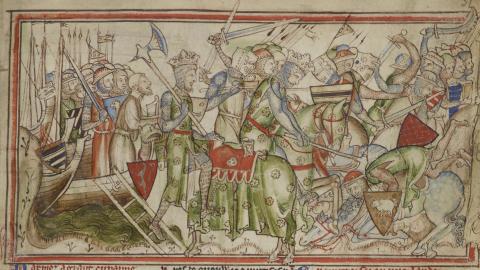
The Holbeche House Siege: Where the Gunpowder Plot met its tragic end
Learn about the events and aftermath of the Holbeche House siege, which followed the failed Gunpowder Plot of 1605.
Image: Painting of the conspirators' last stand at Holbeche House by Ernest Crofts | Artepics/ Alamy Stock Photo
Gunpowder Siege dramatically reimagines the most infamous rebellion plot in British history, shattering the myths to reveal the largely forgotten, gripping truth behind the Gunpowder Plot. Prepare to see the story you thought you knew - blown wide open. The show is available now on Sky HISTORY and HISTORY Play.
Most Brits have heard of Guy Fawkes and his infamous Van Dyke beard. But what about Holbeche House? The Staffordshire manor served as a final hideout for the Gunpowder Plotters of 1605, who just days before had been scheming to blow up the Houses of Parliament and assassinate King James I.
From plot to panic
Rewind to the early hours of 5th November 1605. Guy Fawkes had just been caught red-handed in the cellars of Parliament with 36 barrels of gunpowder, a fuse and a box of matches. His plot to kill the Protestant king and end the persecution of Catholics in England had gone up in smoke… and not in the way he was hoping. With Guy Fawkes imprisoned and the King's forces closing in, the rest of the conspirators fled London.
Robert Catesby, an Oxford University graduate and radicalised Catholic, led the escape. What many people don’t know is that it was Catesby, not Guy Fawkes, who masterminded the Gunpowder Plot. The plan? Head north and stir up support. But first, a pitstop at Holbeche House.
Unfortunately for Catesby and his fellow plotters, the plan fizzled out faster than a damp firework. They arrived at Holbeche House demoralised, weary and wet after travelling through heavy rain. A crackling fire provided a few moments of relief until, in a moment of cruel irony, their damp gunpowder ignited while drying out by the flames. Several men were seriously injured, including Catesby.
The siege begins
The Gunpowder Plotters hideout didn’t stay a secret for long. By the early hours of 8th November, Holbeche House was under siege and surrounded by 200 of the King's men. Sheriff Richard Walsh demanded surrender, but knowing they had nothing left to lose and that their chances of survival were slim, the Gunpowder Plotters chose to fight. They fortified themselves inside the manor and used whatever furniture they could find to barricade the doors and windows.
Armed with muskets and swords, the Sheriff’s forces advanced. The Gunpowder Plotters fired back with a motley collection of weapons, mostly pistols and a few matchlocks.
It wasn’t long before the King’s men breached the manor. Thomas Percy and Christopher Wright were two of the first men to fall. Catesby, already wounded from the explosion the previous night, fought to the end. According to historians, he died clutching a picture of the Virgin Mary to his chest.
A grim aftermath
There was no escape, not to mention mercy, for the men captured alive. Back in London, execution by hanging, drawing and quartering awaited - a harsh reminder of the Crown’s zero-tolerance policy on high treason.
Guy Fawkes was sentenced to the same fate and his execution was scheduled for 31st January 1606. But instead of letting the executioner pull the rope, he jumped from the ladder on his way up to the hanging platform. He broke his neck and died instantly.
Fawkes saved himself from a gruesome end but ultimately the Gunpowder Plot, meant to kill the king and ignite a revolution, instead sparked a nationwide crackdown on Catholics.
A house marked by history
Holbeche House still stands today. Despite its historical significance the property is uninhabited and was recently added to the Heritage at Risk Register maintained by Historic England. Some say it’s haunted by the ghosts of the Gunpowder Plotters, but many believe it should be restored and turned into a museum. While the fate of Holbeche House remains uncertain, there’s no denying it will always hold a unique place in British history books.
Reflections on rebellion
The Holbeche House siege is associated with the failed Gunpowder Plot of 1605. But beyond that, it’s a story of desperation. In many ways, the actions and ultimate downfall of the Gunpowder Plotters show how easily a rebellion can spark when people feel they’ve run out of options.
The aftermath
Today, we remember the Gunpowder Plot every year with bonfires and fireworks. It’s more of a celebration than a memorial. But how often do we think of what came after? The crackdown on Catholics, the fear and suspicion that lingered for decades. Not to mention the terror the Gunpowder Plotters must have felt in those final moments at Holbeche House.
So next time you light that Bonfire Night sparkler, spare a thought for the men of Holbeche House, who died fighting for a cause they believed in, however misguided it may have been.
Just another reminder that history is often more complex, and more human than we like to remember.


















